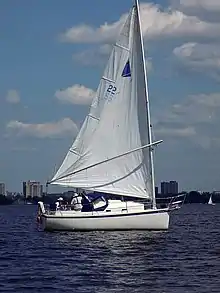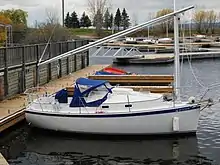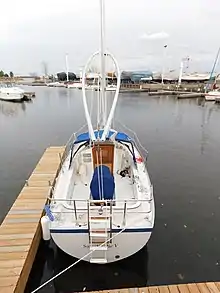Nonsuch 22
The Nonsuch 22 is a Canadian sailboat, the smallest of the series of Nonsuch sailboats. It was designed by Mark Ellis Design and first built in 1984.[1][2]
 | |
| Development | |
|---|---|
| Designer | Mark Ellis Design |
| Location | Canada |
| Year | 1984 |
| No. built | 58 |
| Builder(s) | Hinterhoeller Yachts |
| Boat | |
| Boat weight | 5,000 lb (2,268 kg) |
| Draft | 3.67 ft (1.12 m) |
| Hull | |
| Type | Monohull |
| Construction | Fiberglass |
| LOA | 22.00 ft (6.71 m) |
| LWL | 20.50 ft (6.25 m) |
| Beam | 8.50 ft (2.59 m) |
| Engine type | Westerbeke diesel engine |
| Hull appendages | |
| Keel/board type | fin keel |
| Ballast | 1,800 lb (816 kg) |
| Rudder(s) | internally-mounted spade-type rudder |
| Rig | |
| Rig type | Cat rigged |
| Sails | |
| Sailplan | Catboat |
| Total sail area | 306 sq ft (28.4 m2) |
| Racing | |
| PHRF | 240 (average) |
The design is a scaled-down development of the original, larger Nonsuch 30.[1]
Production
The design was built by Hinterhoeller Yachts in St. Catharines, Ontario, Canada starting in 1984. It went out of production in about 1990. A total of 58 examples were built before production ended.[1][3][4]
Design


The Nonsuch 22 is a small recreational keelboat, built predominantly of fiberglass. It has a catboat rig, an unstayed mast, with a wishbone boom, a plumb stem, a square transom, an internally-mounted spade-type rudder controlled by a wheel and a fixed fin keel. It displaces 5,000 lb (2,268 kg) and carries 1,800 lb (816 kg) of ballast.[1]
The wishbone boom fulfills the role of a traditional boom and vang, as the angled wishbone cane be tensioned downwards to maintain sail shape when sailing downwind. The wishbone boom also provides additional head clearance for the crew.[4]
The boat has a draft of 3.67 ft (1.12 m) with the standard keel fitted.[1]
The boat is fitted with a Westerbeke diesel engine. The fuel tank holds 15 U.S. gallons (57 L; 12 imp gal) and the fresh water tank has a capacity of 23 U.S. gallons (87 L; 19 imp gal).[1]
The design has a large cabin for a 22-foot boat, including an enclosed head and a small galley. During production the boat went through a re-design to correct deficiencies that had resulted from scaling the 22 down from the original 30-foot design. In giving it stand-up headroom, the original 22 was too tall for its beam and the headroom and overall coach house height was reduced in later versions produced.[4]
The design has a PHRF racing average handicap of 240 with a high of 252 and low of 225. It has a hull speed of 6.07 kn (11.24 km/h).[5]
Operational history



In a review for Boats.com, Steve Killing, noted, "The original 22, of which almost 50 were produced, followed the tried and tested Nonsuch formula - a huge interior, standing headroom and high price tag. While the prescription for success worked flawlessly on the larger boats, the 22 had a few problems of scale that were corrected during manufacture of the boat into the late '80s...As with most boats this size, the market the original 22 found itself in was mainly composed of first-time buyers with little knowledge to let them justify the 22's price. I was amazed when Mark Ellis reminded me that the original 22 had an enclosed head and full galley. No wonder the price and freeboard were high."[4]
See also
Related development
Similar sailboats
References
- Browning, Randy (2018). "Nonsuch 22 sailboat specifications and details". sailboatdata.com. Retrieved 28 July 2018.
- Browning, Randy (2018). "Mark Ellis". sailboatdata.com. Retrieved 28 July 2018.
- Browning, Randy (2018). "Hinterhoeller Yachts Ltd". sailboatdata.com. Retrieved 28 July 2018.
- Killing, Steve (24 October 2002). "Nonsuch 22: Classic Catboat". boats.com. Retrieved 28 July 2018.
- InterVisionSoft LLC (2018). "Sailboat Specifications for Nonsuch 22". Sailing Joy. Retrieved 28 July 2018.
External links

